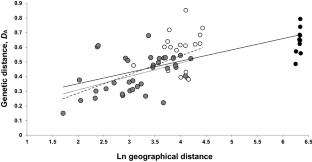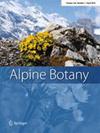Surviving in southern refugia: the case of Veronica aragonensis, a rare endemic from the Iberian Peninsula
Abstract
Understanding in what way cold-adapted mountain species have responded to historical climatic fluctuations in southern European refugia and investigating the genetic variation of endemic species is fundamental to predict their survival under contemporary global climate change. Veronica aragonensis (Plantaginaceae) is a tetraploid species endemic to the Iberian Peninsula that survived the climatic oscillations of the Quaternary. This species is adapted to cold environments and is included in several regional Red Lists due to its small and disjunct distribution range in high-mountain habitats (Pyrenees, Pre-Pyrenees and Baetic System). With the aim of deciphering the phylogeographical processes that underlie the presently disjunct distribution pattern of V. aragonensis and to evaluate its conservation status, we used 9 microsatellite loci to genotype 324 individuals from 12 populations representing the three disjunct areas where the species is distributed. Our results suggest that range fragmentation of an ancient continuous distribution of V. aragonensis—particularly in the low elevation mountain ranges located between the Pyrenees and the Baetic System—during the Last Glacial Maximum is the most plausible explanation for the disjunct distribution pattern of the species. Lastly, the intraspecific genetic patterns are discussed to predict how this endemic species can be affected by global climate warming. Based on the genetic data obtained here, an appropriate evaluation of the conservation status of V. aragonensis and some management strategies are provided.


 求助内容:
求助内容: 应助结果提醒方式:
应助结果提醒方式:


